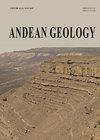智利北部28-29°S三叠纪岩石单元地层及物源分析:冈瓦纳西南缘构造和古地理演化意义
IF 1.2
4区 地球科学
Q3 GEOLOGY
引用次数: 6
摘要
智利北部(28-29°S)三叠纪岩石单元在时间和空间上记录了影响南美洲西南边缘的冈瓦尼亚造山带和安第斯造山带两大造山带的过渡。在这一转变过程中,边缘的地球动力学构造仍然存在争议,特别是在造山运动之间的不同参数下,俯冲是被中断还是继续。为了通过了解边缘的古地理演化来评估这些假设,本研究综合了智利北部(28-29°S)最近的地层、构造和年代学数据,以及该地区两个主要的三叠纪硅屑盆地的碎屑锆石分析和碎屑特征。通过对San fsamulix盆地和Canto del Agua盆地的演化、源区和边缘发掘过程的详细研究,我们认识到弧内/弧前盆地体系发育的两个阶段被卡尼期不整合分隔开。第一期(洛平阶—上中三叠统)发育以瓜纳科-松索组火山碎屑岩为代表的东部弧内盆地和以Chollay深成杂岩为代表的火山弧根部盆地,东部以宾夕法尼亚-西苏拉系基底块体为界。这一阶段的前弧盆地由两个以地形高分隔的海-过渡沉积环境的地堑沉积中心和近端沉积源组成。东部地堑由砾岩和混浊岩组成,分布在San fsamulix组M1至M4段,西部地堑由Canto del Agua组下部的沉积岩和火山岩组成。第二阶段(Norian-Rhaetian)为东部弧内盆地,以La Totora组火山岩为代表,该火山岩封闭了前一阶段发育的岩浆弧的已发现的根;西部为海相-过渡型弧前盆地,以San f本文章由计算机程序翻译,如有差异,请以英文原文为准。
Stratigraphic and provenance analysis of Triassic rock units between 28-29° S, northern Chile: implications on the tectonic and paleogeographic evolution of the southwestern margin of Gondwana
Triassic rock units of northern Chile (28-29° S) record the transition, both in time and space, between two major orogenies that affected the southwestern margin of South America, the Gondwanian and Andean orogenies. The geodynamic configuration of the margin during this transition is still a matter of debate, particularly whether subduction was interrupted or continued under different parameters in between the orogenies. In order to evaluate these hypotheses by understanding the paleogeographic evolution of the margin, this work synthesizes recent stratigraphical, structural and geochronological data from northern Chile (28-29° S), along with detrital zircon analysis and detritus characterization of the two main siliciclastic Triassic basins present in the area. A detailed study of the evolution of the San Félix and the Canto del Agua basins, their source areas, and exhumation processes of the margin recognizes two stages of intra-arc/forearc basins system development separated by a Carnian unconformity. The first stage (Lopingian-uppermost Middle Triassic) develops an eastern intra-arc basin, which is represented by the volcaniclastic rocks included in the Guanaco Sonso Formation and the roots of the volcanic arc represented by Chollay Plutonic Complex, bounded to the east by a Pennsylvanian-Cisuralian basement block. The forearc basin for this stage is constituted by two graben depocenter, separated by a topographic high, of marine to transitional depositional environment and proximal sediment sources. The eastern graben is filled by conglomerates and turbiditic rocks grouped in Members M1 to M4 of the San Félix Formation, and the western graben, by sedimentary and volcanic rocks of the lower section of the Canto del Agua Formation. The second stage (Norian-Rhaetian) involves an eastern intra-arc basin, represented by the volcanic rocks of the La Totora Formation that seals the exhumed roots of the magmatic arc developed in the previous stage, and a marine to transitional forearc basin to the west, represented by the sedimentary rocks of M5 member of the San Félix Formation and the upper section of the Canto del Agua Formation. These two successions show basal fluvial conglomerates unconformably overlying Anisian prodelta deposits of the first stage, recording a major base level drop of the forearc basin.
求助全文
通过发布文献求助,成功后即可免费获取论文全文。
去求助
来源期刊

Andean Geology
地学-地质学
CiteScore
3.90
自引率
0.00%
发文量
17
审稿时长
>12 weeks
期刊介绍:
This journal publishes original and review articles on geology and related sciences, in Spanish or English, in three issues a year (January, May and September). Articles or notes on major topics of broad interest in Earth Sciences dealing with the geology of South and Central America and Antarctica, and particularly of the Andes, are welcomed.
The journal is interested in publishing thematic sets of papers and accepts articles dealing with systematic Paleontology only if their main focus is the chronostratigraphical, paleoecological and/or paleogeographical importance of the taxa described therein.
 求助内容:
求助内容: 应助结果提醒方式:
应助结果提醒方式:


